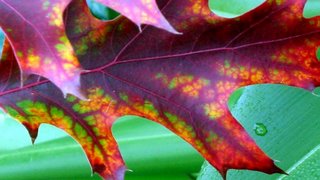
Book Review: AUTUMN ACROSS AMERICA
*Note: This book review was created for a class at TWU.
Photograph courtesy of www.mooseyscountrygarden.com
1. BIBLIOGRAPHY:
Simon, Seymour. 1993. AUTUMN ACROSS AMERICA. New York, NY: Hyperion Books for Children. ISBN 0152163956
2. PLOT SUMMARY:
Author Seymour Simon takes the reader on a photographic journey across America in autumn while describing the scientific reasons for the season, along with its effects on flora, fauna, and man in this informational trade picture book. Beginning with a description of autumn's beauty, continuing with information about why the seasons change, why leaves change colors and fall, why animals migrate, how the season affects insects, how plants distribute seeds during the autumn, and how the season differs in each region of America, the book ends as it began, with a description of autumn's beauty and meaning for the Earth.
3. CRITICAL ANALYSIS:
Although AUTUMN ACROSS AMERICA was written more than 10 years ago, it contains many of the qualities that have come to define engaging informational picture books in recent years. The book's design is very attractive, with a beautiful mix of text and photography that draws the reader from page to page, alternating breathtaking landscape shots of trees, country roads, and mountains, with close-ups of fallen leaves, unusual insects, and pumpkins. The most striking picture is that of the lowly milkweed, releasing its seeds like a miniature fireworks display. The text accompanying the milkweed picture intertwines in-depth factual information such as "Seeds...contain an embryo, or young plant, and a supply of food," with more lyrical descriptions of how the seeds are scattered. "When a pod splits open in October," writes Simon, "only a few seeds at a time are released. Their silken parachutes catch the faintest breeze, and they sail off to unknown destinations." Such compelling details, and little known facts, as in the section on the monarch butterfly, which flies "from ten to 15 miles per hour, traveling eighty miles or more a day," are enhanced with fascinating comparisons. Seeds are "travelers" "hitchhiking" and aspens are a "slash of golden light" amid the green of fir trees. While the colorful subject matter will appeal to younger readers, Simon does not "dumb down" the vocabulary, using scientific terms that will inform older readers as well. For this reader, who quickly tires of theories, facts, and figures, AUTUMN ACROSS AMERICA was a refreshing and eye-catching change, and a reminder that the seasons both inspire poetry and serve nature's purposes.
4. REVIEW EXCERPT(S)
School Library Journal: "Since there is no index and no table of contents, children looking for specific information will be frustrated. The book's main attraction is its design-beautiful photographs set in pages of glowing fall colors... Seasonal materials are always in demand; this one is a good choice for browsers."
Booklist: "Simon's first book in a series about the changing seasons introduces autumn as a 'season of memory and change.' By the book's end, readers will grasp the significance of that phrase. Throughout this tribute, each double-page spread contains at least one, sometimes two, four-color photographs of a typical fall scene opposite two or three paragraphs of Simon's information-packed text, all appearing on a brilliant background color. This makes each turn of the page a delightful shock, not unlike the astonishment of seeing the first orange tree of fall."
5. CONNECTIONS
*Use this book with others about how foliage changes such as Sylvia Johnson's HOW LEAVES CHANGE (ISBN 0822595133) and AUTUMN LEAVES (ISBN 0590298798) by Ken Robbins to support students in creating an observation notebook of changes in foliage in their own neighborhood. This could help to teach the scientific method, descriptive writing, or, in combination with students' photographs, become the basis of a photo essay. Other activities connecting to fall foliage and photosynthesis can be found on EducationWorld at: http://www.educationworld.com/a_lesson/lesson/lesson024.shtml
* Using Simon's format as a model, older students in World Geography could write their own "Autumn Across _____________" children's book, choosing different countries, continents, or regions of the world. Students could then present the books and discuss similarities and differences in the season around the world.
*Read "Autumn Across America" and other nonfiction titles about the seasons in conjunction with selected poems from POETRY FOR YOUNG PEOPLE: SEASONS (ISBN 1402712545) to inspire seasonal poetry writing.

No comments:
Post a Comment